How do I get the best medical bracelet for me?

Getting Started
• Organize your med info
• What to put on a medical bracelet
• Paramedic guidelines
Talk to your doctor
Ask what critical issues need to be listed, and in what order of importance.
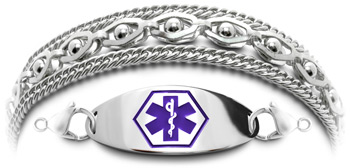
Organize your med info
• Plan your ID tag information to be clear and concise. See Abbreviations
• Medical conditions are usually the most important.
• Arrange your medical issues and drugs in order of importance because medical responders may only have seconds to make life saving decisions.
• Names and phone numbers are the least important as responders and doctors do not have time to make calls.
• For Alzheimer's patients, phone numbers are needed, but only after their medical issues are stated. See Alzheimer's
What to put on a medical bracelet
List All Allergies to medications, foods and anything else that might cause an emergency, or what needs to be said to get you through a crisis such as NO NUTS, NO PCN, NO MORPHINE, NO BEES-USE EPIPEN.
Diabetes Patients need to communicate DIABETIC 2-MEDS, DM1-INSULIN DEP, DM1-INSULIN PUMP, etc. Diabetes Orgs. recommend using Arabic numbers and not Roman numerals to avoid confusion. See *HealthCentral -**ADA and see below
NO MRI for most pacemakers, defibrillators and stimulators: NO MRI: PACEMAKER, NO MRI: ICD (implantable cardiac defibrillator). List ferrous metal implants such as plates, pins, cerebral & heart aneurysm clips, screws, stents and meshes: NO MRI: PIN L-LEG, NO MRI: PLATE-HEAD, NO MRI: BRAIN CLIP. Better to be safe than sorry: Read FDA "MRI Risks" and "Patients with Implants"
"MRI Safe" Implants? While newer implantable devices can have MRI scans, it's complicated. Even a pacemaker that's declared "MRI Safe" must first be turned off and the MRI settings must be lowered from normal MRI levels to whatever is deemed safe. A technician from that Pacemaker company maybe present and the pacemaker maybe reprogrammed after the scan. The pacemaker brand and model must be on the ID tag.
Alzheimer's or Dementia can be described as FORGETFUL, MEMORY LOSS, or ALZ. See Alzheimer's Guide
Artificial Knees, Hips & Spine Injuries—specify where located: R-KNEE: TKR (total knee replacement), L-HIP: THR (total hip replacement), SPINE MESH-SCI (spinal cord injury).
Lymphedema Patients cannot have blood pressure taken or needle punctures such as R-ARM: NO BP/IV, NO NEEDLES/LABS.
Artificial heart valves & heart conditions: List CHF (chronic heart failure) or CABG (coronary artery bypass graft).
Bariatric Bypass Surgery: Tell not to insert a blind gastric tube to avoid stomach punctures such as: GASTRIC BYPASS, NO BLIND NGT.
Transplant Patients need to specify the type of transplant and anti-rejection meds such as heart, kidney or lung transplants: KIDNEY TX, HEART TX, ON CELLCEPT, ON PROGRAF.
Allergies to Med Classes: NO OPIOIDS, NO SULFA, NO CILLINS, NO MYCINS.
What trained paramedics do and don't do
• First they feel around both wrists for a medical bracelet
• If no bracelet, they look around your neck
• Last place they look is around your ankles
• They'll read all information on both sides of the tag
• They're especially concerned about blood thinners
• They don't have time to make phone calls
• They're reluctant to go into wallets without police observers
_________________
Diabetes Patients (cont. from above)
Classification Change from Roman Numerals to Arabic Numbers
* "Type I" and "Type II" diabetes – later adjusted to remove the capitalization and change the Roman numerals to Arabic, thus becoming type 1 and type 2 diabetes. These are the presently-used terms.
- Dr. Bill Quick, Health Pro, HealthCentral, Published On: August 29, 2013.
**Report of the Expert Committee on the Diagnosis and Classification of Diabetes Mellitus (American Diabetes Association)
"The terms type 1 and type 2 diabetes are retained, with Arabic numerals being used rather than roman numerals. We recommend adoption of Arabic numerals in part because the roman numeral II can easily be confused by the public as the number "11" - Diabetes Care Jan 2003, 26 (suppl 1) s5-s20; DOI: 10.2337/diacare.26.2007.S5
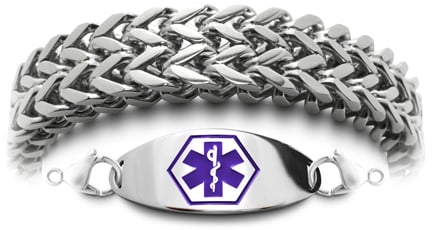 Unremovable GPS Tracking
Unremovable GPS Tracking

Make your existing GPS or RFID watch style pendant into an unremovable bracelet. For people that need an unremovable tracking system for Alzheimer's, Dementia and Autism — this is the answer you've been waiting for. Call 847-638-2223 for details.
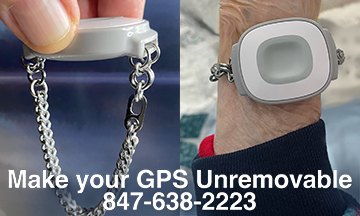
Unremovable AirTag® bracelets. Includes bracelet and AirTag® holding-case. AirTag® inside not included. Requires Apple iOS 14.5 or later. For more details.
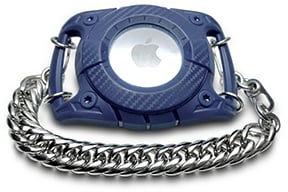
Abbreviate and say more
Because every second counts in emergencies, you need to say more, and say it faster. So help paramedics and doctors save your life by fitting all critical medical issues onto your ID Tag. See details
Why use ON and NO: Paramedics and doctors need to know quickly if you are taking meds, or can't take them. That's why "ON" tells them that you must take a medication that is critical to your health. For example: ON COUMADIN.
On the other hand, the word "NO" tells them that you're allergic to specific meds, foods or even anaphylactic. For example: NO MORPHINE or NO SHELLFISH. Make sure you tell them if you're taking or can't take meds to avoid any confusion.
Space is at a premium on an ID so be sure to shorten the information. Instead of saying "TAKING PENICILLIN", you can say ON PCN.
It's too long to say "DIABETIC TYPE 2 TAKING INSULIN" when you could say DM2-INSULIN or DIABETIC 2-INSULIN.
First responders and doctors are trained to know the shorthand. See Abbreviations.
Medical Conditions don't have to be long to be clear to medical people.
"KIDNEY TRANSPLANT" can be written as KIDNEY TX. "ATRIAL FIBRILLATION" is AFIB. "AORTIC VALVE REPLACEMENT" is AVR.
Emergency Phone Numbers are stated as "ICE" which stands for "In Case of Emergency".
This would precede the number: ICE 888-234-5678. It's best to have a cell number of a family member or close friend who knows your medical issues.
However, don't count on any phone number to be called by paramedics or doctors as they are usually too busy saving your life. So make sure all critical information is stated on your ID Tag.
What May Not Be Reliable
Lost wallets and broken phones may prevent retrieving your medical information in emergencies such as car accidents. Just because you have a medical card in your wallet does not guarantee that your wallet will be found or searched.
Even your cell phone may be broken or lost in the weeds.
That's why you can only rely on a medical ID that's securely attached.
Cellular Rescue Services with buttons or fall detection are great for people at severe risk, but may not be enough in every medical emergency.
Pressing a button and having your fall detected gets medical services to you quickly. However, once the emergency people get there, will they be completely informed about your pre-existing conditions?
In speaking with paramedics across America, they say they are usually too busy to make phone calls if that's required.
And, if the service can speak through the speaker, the information must be given quickly without delay otherwise they can't wait.
What if you're in a no-service cell zone—where is the information then?
Having a medical ID bracelet is usually the quickest, surest way to convey your pre-existing conditions, your allergies, and what meds you are taking—right there on the spot—when every second counts!
It only makes common sense to protect yourself in every way possible—a cellular service and a bracelet!
98% of medical USB's and QR Codes are useless in America. After researching what paramedics, hospitals and doctors will actually do, it turns out that in a middle of an emergency they have no time to access the equipment needed to read personal USB's and QR Codes on medical bracelets.
As a matter of policy, most hospitals and first responders are forbidden to insert any private media into official computers for fear of viruses. Also in emergencies, USB's take too much time to load and read.
Most paramedics are not allowed to use their personal or hospital phones to read QR codes because of policy and HIPAA compliance. In most cases, there are "no universal standards" and no specialized scanners to permit reading these codes.
Also, be aware that most QR codes require a cellular connection to the internet to retrieve your medical information. Mountains, valleys and heavily forested areas can block this service.
At this time, there is no nationwide Federal hospital standards to coordinate and read these devices.
If you intend to use one of these devices or codes, make sure your area hospitals and EMT's can read and accept your data before investing in this technology.
Keep in mind, if you venture out of your area, it won't work.
The problem with 800-number medical data services. Any service providing important medical information is helpful.
However, paramedics are usually too busy saving lives and unfortunately have no time to make calls to any phone service.
Even doctors in emergency rooms are also too busy to call. It's only when an unconscious person comes out of the ER—that's when nurses usually call for more information.
Having a number for a medical data service on your ID tag can help—after the emergency is over!
It's always better to have all "critical information" firmly attached to you.
Measuring Correctly
• Note: You'll be asked to confirm your correct wrist size by email, text or phone after the order to avoid extra costs for resizing.
• For more details go to How to Size
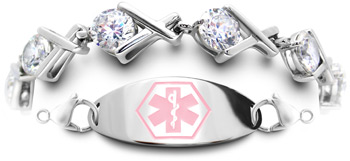
Selecting the right bracelet
Up to now, finding the right medical bracelet has been a hit-and-miss affair. You pay good money only to find it doesn't fit, it doesn't last, and unless you spend a fortune, it looks like it belongs around your dog's neck. But you're up against it because your doctor says you must have one to survive yet another day.
So consider these issues:
• WaterWear Bracelets®
• Upscale/Dressy
• Heavy Duty Activities
• At Work
• Alzheimer's, Dementia, Autism
• Precious Metals
• Designer Stainless
• Limited Budgets
• Metal Interactions to Meds
When Wearing Bracelets in Water it's best to use our stainless steel WaterWear Bracelets®. Designer Stainless and Precious Metals can both be worn in showers, baths and swimming. However, if you're swimming in chlorine and salt water, you may want to avoid Precious Metals as they can be etched by chlorine, salt and even chemicals like perfumes and sunscreens. In some cases, people with high acid skin can even damage gold, silver, platinum, and rhodium.
Upscale/Dressy is for special occasions whch makes our Tennis Bracelets a perfect solution. Within our Precious Metal and Designer Stainless you can also find some very dressy styles.
Heavy Activities create high stress and rough wear situations requiring stronger materials such as heavier chain styles in Designer Stainless. Even stainless steel can be broken unless you choose wisely for your lifestyle.
At Work the style you pick is determined by what you do. If you're a Chef, you'll probably want a WaterWear Bracelet®. If you have a desk job, you can go with just about anything that strikes your fancy. If heavy construction is your profession, than choose a more rugged stainless steel style.
Alzheimer's, Dementia & Autism patients may eventually become hard to handle and may not want to wear, or keep wearing a medical bracelet. This requires specially designed unremovable bracelets built to be secure.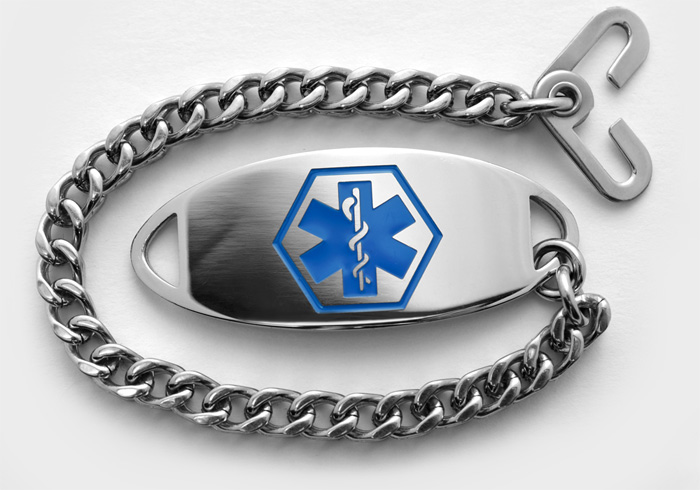
Precious Metals at Medical ID Fashions are in Gold and Rhodium. Rhodium looks just like Silver except it is much harder and more scratch resistant. Rhodium is a rare precious metal that is often used to plate sterling silver and found in high-end watches. Be aware, all precious metals can be compromised by chlorine, salt, chemicals and high acid skin. If you swim in chlorine or salt water, then always use fresh water to wash off gold and rhodium immediately after swimming.
Designer Stainless bracelets are much more stylish than the stereotypical and ugly drugstore chains that look like something Fido would wear. To correct this, we go all over the world for styles that you'll never see anywhere else. They can be very delicate or they can be very rugged. It's up to you and your lifestyle!
Limited Budgets can put a crimp into your style unless you come to where you get the most for your money. See Budget Sets
We offer Designer Sets and Alzheimer's Sets. In both cases, each bracelet style comes with the plate and engraving all included at one low price.
For ALZ we've designed exclusive sets that use a one-of-a-kind "sisterhook" clasp that's virtually unremovable.
Metal Tarnishing from Skin and Meds
may occur for some customers. Your body skin chemistry or medications can actually tarnish or etch the bracelet material whether it be pewter, alloy, gold, silver, platinum or rhodium. Also see Acid Skin
This is often seen with people that are on chemotherapy and/or taking anti-rejection meds for organ transplants. It does not rule out unique medication combinations.
It can also occur naturally for some people that have very high acid skin.
If you believe you fit one of these conditions, or have experienced problems with ordinary metals, it's best to only consider stainless steel.
Production & Delivery Time
Because too many customers don't always follow website sizing instructions, we require a confirmation by phone or email to insure correct size and avoid extra time and expense. All bracelets are custom handmade. While we generally allow 2 weeks delivery time after size confirmation, faster delivery is often achieved. Shipping methods also affect delivery time.
